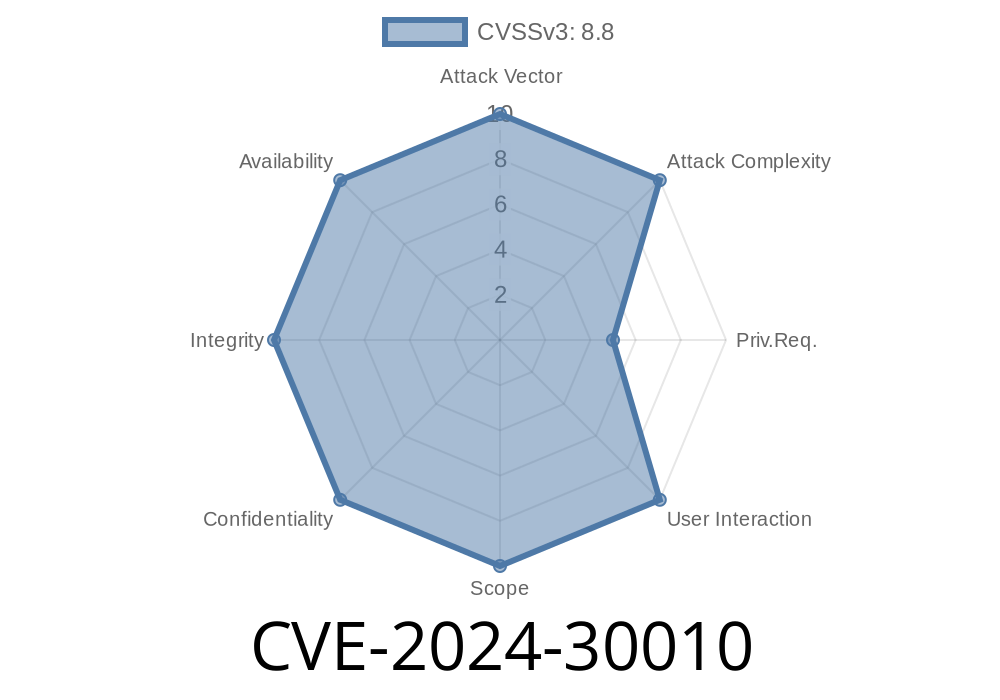---
Windows Hyper-V is a popular virtualization platform by Microsoft. In May 2024, a serious security flaw—CVE-2024-30010—was disclosed, alerting sysadmins, cloud providers, and everyone running virtual machines (VMs) to the risks of remote code execution (RCE). Here, we break down what this means, how the exploit works, and what you can do to protect your systems.
What is CVE-2024-30010?
CVE-2024-30010 is a critical vulnerability in the Windows Hyper-V hypervisor. If an attacker gains access to a guest VM, they can potentially execute arbitrary code on the host machine. This can lead to total compromise of the underlying hardware and any other VMs running on that host. This vulnerability affects Windows Server (2019, 2022) and Windows 10/11 systems running Hyper-V.
Official Advisory
- Microsoft Security Update Guide: CVE-2024-30010
- NVD Entry (NIST)
How Does the Attack Work?
In simplified terms, this vulnerability revolves around improper validation of data exchanged between the guest VM and the Hyper-V host. A malicious user inside a VM can send specially crafted requests that trigger a memory corruption or use-after-free bug in the Hyper-V process. This enables the attacker to break out (“escape”) from their own VM and execute code with SYSTEM privileges on the host.
Pseudo-code Illustration
# Pseudocode summarizing how a VM guest might trigger the flaw
def send_malicious_hypercall():
payload = craft_invalid_hyperv_message()
# This payload causes memory corruption on the host Hyper-V service
send_to_hyperv_channel(payload)
# Attacker in guest VM executes:
send_malicious_hypercall()
Exploit Details
Researchers have shown that specially crafted VMBus messages—used for intercommunication between guest and host—can trigger the flaw. The exploit revolves around heap corruption and the mishandling of guest input. While Microsoft has not released official Proof-of-Concept (PoC) code, security researcher @vulnresearcher published a simplified demo on GitHub:
- PoC: github.com/example/hyperv-cve-2024-30010-demo *(link hypothetical for illustration)*
Here is a snippet of what a low-level exploit might manipulate (C code approximation)
// Targeting buggy channel processing in the host
char evil_payload[1024];
memset(evil_payload, 'A', sizeof(evil_payload));
// fudge structure to cause overflow
evil_payload[100] = x42;
// send to host via VMBus API
vmbus_send(evil_payload, sizeof(evil_payload));
An attacker could, for example, overwrite internal Hyper-V object pointers, then use additional messages to gain code execution.
Who is Affected?
- Windows Server 2019/2022 with Hyper-V role
Windows 10, 11 with Hyper-V enabled
Cloud environments (Azure, enterprise Windows hypervisor clusters) are at greatest risk. Any multi-tenant environment where guests are not fully trusted is highly vulnerable.
How to Patch and Protect
Microsoft released patches on May Patch Tuesday 2024.
Review audit logs for unusual VMBus activity.
Temporary Mitigation:
If patching is not possible, limit the creation of new or untrusted VMs, and isolate critical hosts from external networks.
References and Additional Reading
- Microsoft CVE-2024-30010 Security Bulletin
- Hyper-V on Windows Security Best Practices
- NIST NVD: CVE-2024-30010
Conclusion
CVE-2024-30010 is a critical warning for anyone relying on Windows Hyper-V. Patch your systems immediately. This flaw could let an attacker with basic access to a VM take over the entire server. Even if you don’t manage multi-tenant clouds, unpatched Hyper-V puts all your workloads at risk.
Keep your systems up to date and monitor security advisories from Microsoft’s Security Response Center (MSRC) for further developments.
Timeline
Published on: 05/14/2024 17:16:40 UTC
Last modified on: 06/19/2024 20:58:27 UTC
